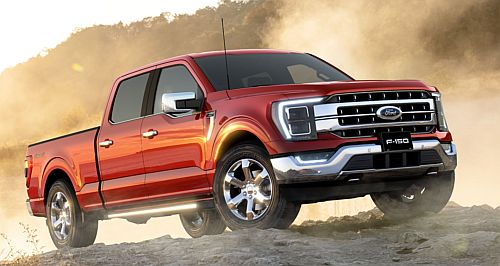News - Ford - F-150Ford F-150 waste and recycling issue surfacesRe-manufacturing Ford's full-size pick-up for Australia generates significant waste27 Sep 2023 FORD Australia’s new right-hand-drive F-150 pick-up truck rolls out of the RMAA remanufacturing facility in Melbourne with more than 500 parts changed from the donor left-hand-drive vehicle that arrives here.
So, what happens with the waste?
It is a question that perhaps will not be top of mind for the type of customer that is keen to buy a massive American pick-up truck, but it is clearly at odds with the increasing global push for more ecological and sustainable vehicle production.
The project – which essentially sees an Aussie facility pull apart completed vehicles, bin a bunch of perfectly usable gear, and then replace a number of those items with new ones that have been ordered from around the world – is a concern.
Ford Australia’s F-150 Assistant Chief Program Engineer, Tom Dohrmann, admitted that waste is a part of this production program.
“There is a bit of waste. I guess, some of the things that we have no option but to scrap,” he said.
“I know that RMA Automotive is working on ways to recycle whatever they can.
“Last time we were out at RMA there was a long discussion around recyclability and reuse. I know they are working with some third parties to find out what is being scrapped, what can be recycled.”
Mr Dohrmann explained that Ford Australia is working with the Deaborn, Michigan plant to reduce the number of items that are excess to requirements for the re-manufacturing process in Australia, but indicated that it really is a work in progress.
He said that Ford Australia is on the Product Direction Ladder for the production plan, which he said was a “key enabler” for Australia to get modules specifically changed on the production line in preparation for our market, such as the Sync media screen system, the modem and the router.
“We were going to have to change them here locally, because we had a Canadian spec, originally,” he added.
“What that would have involved would have been scrapping the module, and in the chip-shortage climate, that doesn’t bode very well.
“So, we managed to get those modules into the truck, and there’s other things that we’re looking at to get more efficiencies.”
He said that with that in mind, the models being built on the line are designated as Australian vehicles, they are built specific to our certain requirements, but they just happen to remain left-hand drive in layout, with specific technical differences because of that.
Exactly how much waste is produced and what is recycled remains unknown, but there is significant work undertaken to remanufacture the right-hand drive versions of the F-150.
Replaced items include the carpets due to the different foot well requirements (including a driver’s footrest), a new cross-car beam and instrument panel carrier, new HVAC system, dashboard and cowl panels, new electrical harnesses, new steering rack and shaft assembly, different exterior mirrors, new windscreen wiper layout, cowl and linkages, and a new towbar assembly (with standard 4500kg hitch and 70mm tow-ball).
Further, there is new interior trim on the dashboard, new brake pedal assembly and brake lines, and new switches for the doors.
The team at the RMA Automotive facility also rebuild a number of components, including the transmission shifter assembly, the LED headlights for the Lariat (which would not otherwise be ADR-compliant), the addition of specific software for the media system, and also the re-manufacture of the driver’s seat memory settings.
Andrew Birkic, Ford Australia CEO, said that the program started “in earnest” about three years ago, with the planning, organisation and business case sign-off leading, ultimately, to a throughput of 20 vehicles per day at the RMA Automotive facility in Mickleham, north of Melbourne.
“If you think about where we were three years ago, we were in COVID. Chip challenges, supply challenges – difficulties, right?” he said.
“So, this underlines the brilliance of some of the people involved, to get through all that, and the backing of our parent company to say, ‘we think you’re doing the right thing, we support you’.
“And this is unique in the Ford world, and that’s something I’m incredibly proud of, for Ford Australia and its partners, to be innovative and find a way to get it done despite the COVID environment
“In a ‘normal’ program, you’d just send people, there’d be ins and outs, people flying in and out. There wasn’t that luxury. So I think the team has done a super job.”
Initially, Ford Australia and RMA Automotive are predicting a production throughput of 20 vehicles per day through just a single shift. That may increase if demand dictates.
Ford Australia is offering the new F-150 large pick-up truck in two different trim levels, XLT and Lariat. Buyers can also choose between short- and long-wheelbase versions of the ute, both of which are capable of a maximum braked towing capacity of 4500kg.
The order books for the Ford F-150 are open now, with pricing starting from $106,950 plus on-road costs.
 |
Click to shareFord articlesResearch Ford Motor industry news |














Facebook Twitter Instagram